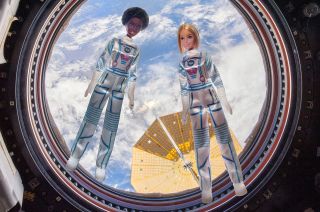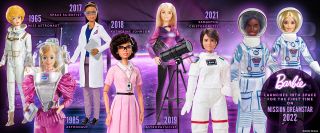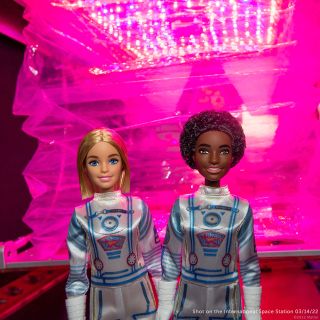Trading dress-up for lift-off, Barbie flies on space station for first time
"Have you ever dreamed of what it would it be like to go to outer space? I know I have!" — Barbie

After almost 60 years of dressing up like an astronaut, Barbie has launched into space for real.
Two of the iconic fashion dolls are now on board the International Space Station (ISS), where they are part of "Mission DreamStar," an outreach project to inspire girls to consider careers in aerospace and science, technology, engineering and mathematics (STEM) fields. As revealed by Mattel on Thursday (April 14), the dolls have been in Earth orbit since February as part of a collaboration between the toy company and the ISS U.S. National Laboratory.
"Barbie has a long history with space exploration, having introduced an astronaut doll in 1965 before humans even stepped foot on the moon, so the idea of Barbie going to space has been top of mind for a while!" Lisa McKnight, executive vice president and global head of Barbie and dolls at Mattel, said in an interview with collectSPACE.com. "With the launch of our Space Discovery line at Target, this year presented the perfect opportunity to create this milestone moment and finally send Barbie to space and the ISS."
In photos: Barbie and space exploration: The iconic doll's astronaut looks (photos)
As featured in a newly released special episode of the brand's "You Can Be Anything" web video series, the two diverse Barbie dolls have been filmed floating inside the space station's multi-windowed Cupola backdropped by Earth below. They have also accompanied NASA astronaut Kayla Barron, a member of the station's Expedition 67 crew, while she explained some of the research conducted on the orbiting laboratory, including the Veggie plant growth facility and Astrobee free-floating robots.
"Every single day we do cool science and engineering research here," said Barron in the video, which also features NASA astronaut Raja Chari.
"Have you ever dreamed of what it would it be like to go to outer space? I know I have!" says an animated version of Barbie in the episode.
Get the Space.com Newsletter
Breaking space news, the latest updates on rocket launches, skywatching events and more!
The pair of dolls sent into space are modeled after the astronauts and cosmonauts who live on the station. Each is dressed in the same one-piece outfit loosely based on the Sokol pressure garments worn by crew members who launch and land on Russia's Soyuz spacecraft.
"Barbie's shimmery spacesuit, helmet and gloves incorporate nods from real life spacesuits seen on the ISS, with signature pink accents," said McKnight. "We're excited that kids will be able to play with Space Discovery dolls just like the ones in orbit to make their doll play even more imaginative."

Over the past 57 years, Barbie's space wear has varied from fashion-forward to miniature replicas of the real thing. The first astronaut outfit, "Barbie Miss Astronaut" released in 1965, was inspired by the silverly suits worn by the Mercury astronauts. Twenty years later, Barbie modeled a bright pink and silver spacesuit "with sparkly skirt and tights."
Since 2019, Mattel has honored real-life astronauts with Barbie dolls bearing their likeness. Part of the brand's Inspiring Women series, Barbie dolls have been styled after first American woman in space Sally Ride and Russian cosmonaut Anna Kikina.
Another Barbie resembling European Space Agency (ESA) astronaut Samantha Cristoforetti is set to launch to the space station with her real-life counterpart later this month.
"While separate from Mission DreamStar, we look forward to Samantha's flight and continuing to celebrate STEM," McKnight told collectSPACE. "Samantha Cristoforetti's doll continues to fuel Barbie's history with space and the brand's commitment to encourage girls to become the next generation of astronauts, engineers and space scientists."

The Barbie dolls now in space are expected to return to Earth this summer, when they will be sent to the Smithsonian to go on display at the National Air and Space Museum's Steven F. Udvar-Hazy Center in northern Virginia.
The Space Discovery line, now for sale exclusively at Target, includes Barbie dolls identical to those launched to the station, as well as dolls of Barbie's friends dressed in spacey outfits and related playsets.
"The Barbie purpose has always been to remind girls that they can be anything. By offering an inside look at the ISS through real life astronauts, Barbie is proud to encourage kids to consider careers in aerospace and STEM," said McKnight.
Click through to collectSPACE.com for more photos of the Barbie Dolls on board the International Space Station.
Follow collectSPACE.com on Facebook and on Twitter at @collectSPACE. Copyright 2022 collectSPACE.com. All rights reserved.
Join our Space Forums to keep talking space on the latest missions, night sky and more! And if you have a news tip, correction or comment, let us know at: community@space.com.

Robert Pearlman is a space historian, journalist and the founder and editor of collectSPACE.com, an online publication and community devoted to space history with a particular focus on how and where space exploration intersects with pop culture. Pearlman is also a contributing writer for Space.com and co-author of "Space Stations: The Art, Science, and Reality of Working in Space” published by Smithsonian Books in 2018. He previously developed online content for the National Space Society and Apollo 11 moonwalker Buzz Aldrin, helped establish the space tourism company Space Adventures and currently serves on the History Committee of the American Astronautical Society, the advisory committee for The Mars Generation and leadership board of For All Moonkind. In 2009, he was inducted into the U.S. Space Camp Hall of Fame in Huntsville, Alabama. In 2021, he was honored by the American Astronautical Society with the Ordway Award for Sustained Excellence in Spaceflight History.

